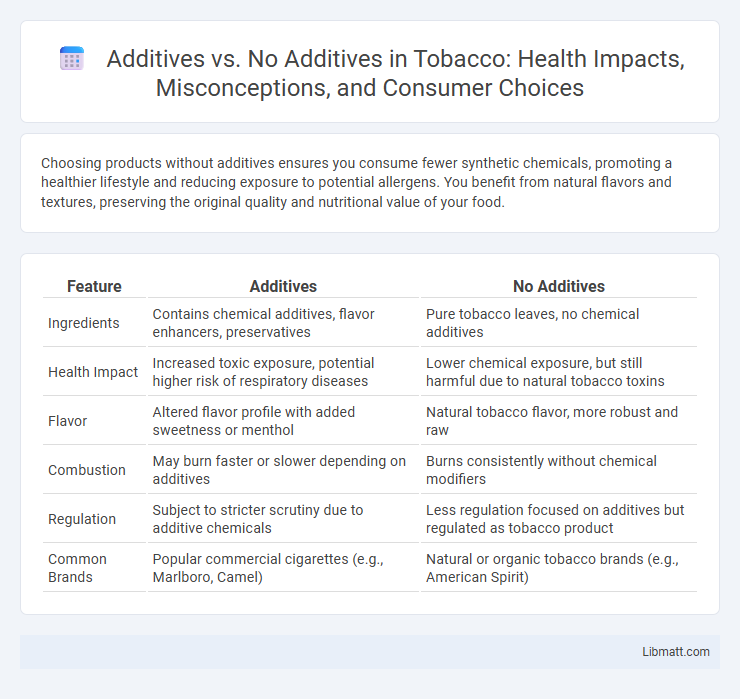Choosing products without additives ensures you consume fewer synthetic chemicals, promoting a healthier lifestyle and reducing exposure to potential allergens. You benefit from natural flavors and textures, preserving the original quality and nutritional value of your food.
Table of Comparison
| Feature | Additives | No Additives |
|---|---|---|
| Ingredients | Contains chemical additives, flavor enhancers, preservatives | Pure tobacco leaves, no chemical additives |
| Health Impact | Increased toxic exposure, potential higher risk of respiratory diseases | Lower chemical exposure, but still harmful due to natural tobacco toxins |
| Flavor | Altered flavor profile with added sweetness or menthol | Natural tobacco flavor, more robust and raw |
| Combustion | May burn faster or slower depending on additives | Burns consistently without chemical modifiers |
| Regulation | Subject to stricter scrutiny due to additive chemicals | Less regulation focused on additives but regulated as tobacco product |
| Common Brands | Popular commercial cigarettes (e.g., Marlboro, Camel) | Natural or organic tobacco brands (e.g., American Spirit) |
Introduction to Food Additives
Food additives are substances added to products to enhance flavor, texture, preservation, and appearance, playing a crucial role in modern food processing. Choosing foods without additives can reduce exposure to artificial chemicals and potential allergens, contributing to cleaner, more natural nutrition. Understanding the types and purposes of additives helps you make informed decisions about your diet and health.
Understanding "No Additives" Labels
No Additives" labels indicate products free from artificial preservatives, colors, flavors, and other synthetic chemicals, ensuring a more natural composition. Understanding these labels helps you avoid hidden additives that may affect health or cause allergies. Choosing no additives supports cleaner ingredient lists and promotes transparency in food quality.
Types of Common Food Additives
Common food additives include preservatives such as sodium benzoate, antioxidants like ascorbic acid, colorants such as tartrazine, flavor enhancers including monosodium glutamate (MSG), and emulsifiers like lecithin. These additives are designed to improve shelf life, maintain flavor, enhance appearance, and stabilize food texture. Understanding the differences between additives and no additives can help you make informed choices about your food consumption and its potential health impacts.
Purposes and Functions of Additives
Additives serve essential purposes in enhancing the quality, shelf life, texture, and flavor of food products by preventing spoilage, improving appearance, and maintaining consistency. In contrast, no additives mean food is free from synthetic preservatives, colorants, or flavor enhancers, appealing to those seeking natural or organic options. Your choice between additives and no additives impacts product safety, nutritional value, and consumer preferences in the food industry.
Health Impacts: Additives vs No Additives
Consuming products without additives reduces exposure to artificial preservatives, colorants, and flavor enhancers linked to allergic reactions, headaches, and other health issues. Additives like sodium nitrite and monosodium glutamate (MSG) may contribute to hypertension, asthma, or digestive discomfort in sensitive individuals. Your choice to avoid additives can support better overall health by minimizing potential long-term risks associated with synthetic compounds and promoting cleaner nutrition.
Consumer Perceptions and Preferences
Consumers generally associate additives with potential health risks, preferring natural products that promote wellness and transparency. You are more likely to trust brands that highlight "no additives" as a marker of quality and purity, impacting purchasing decisions significantly. Market studies reveal a growing demand for additive-free goods fueled by increased awareness of ingredient safety and clean-label trends.
Additive-Free Foods: Benefits and Myths
Additive-free foods are often praised for their natural composition, reducing exposure to synthetic chemicals and potential allergens commonly found in processed products. Research indicates that consuming additive-free options may support better digestive health and decrease the risk of adverse reactions, although some additives are safe and necessary for preservation and safety. You can enhance your diet by choosing whole, minimally processed foods, but it's important to understand that not all additives are harmful, and avoiding them entirely is not always essential for a healthy lifestyle.
Regulatory Standards for Food Additives
Regulatory standards for food additives are established by agencies such as the FDA in the United States and EFSA in the European Union to ensure safety, proper usage levels, and clear labeling. These standards include rigorous testing for toxicity, allergenicity, and long-term health effects before approval. Foods labeled as "no additives" must comply by excluding synthetic preservatives, colorants, or flavor enhancers, whereas products containing additives adhere strictly to these regulatory limits.
Choosing Between Additives and No Additives
Choosing between additives and no additives depends on individual health preferences and product transparency. Additives can enhance flavor, texture, and shelf life but may contain synthetic chemicals that some consumers prefer to avoid. Opting for products without additives often means selecting natural, minimally processed foods that align with clean eating and reduce exposure to potential allergens or irritants.
Future Trends in Food Processing and Additives
Future trends in food processing prioritize clean-label products with no additives to meet consumer demand for transparency and health-conscious choices. Innovations in natural preservatives, such as plant-based extracts and fermentation byproducts, enhance shelf life without synthetic chemicals. Your preference for additive-free foods aligns with a growing shift towards sustainability and minimally processed ingredients.
Additives vs No additives Infographic

 libmatt.com
libmatt.com